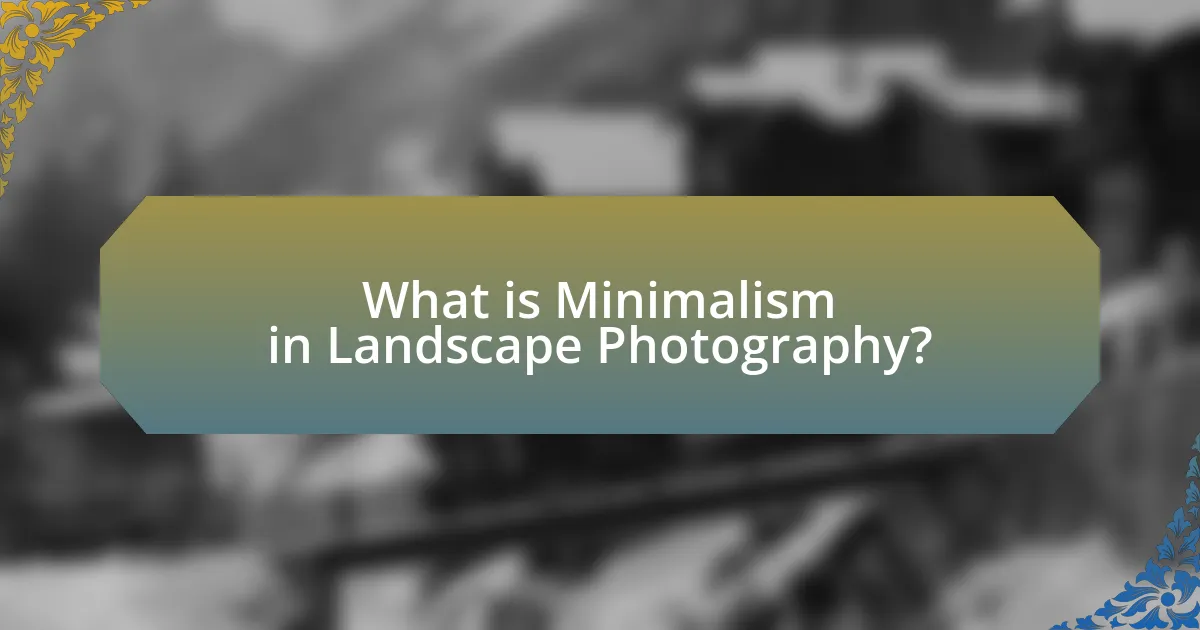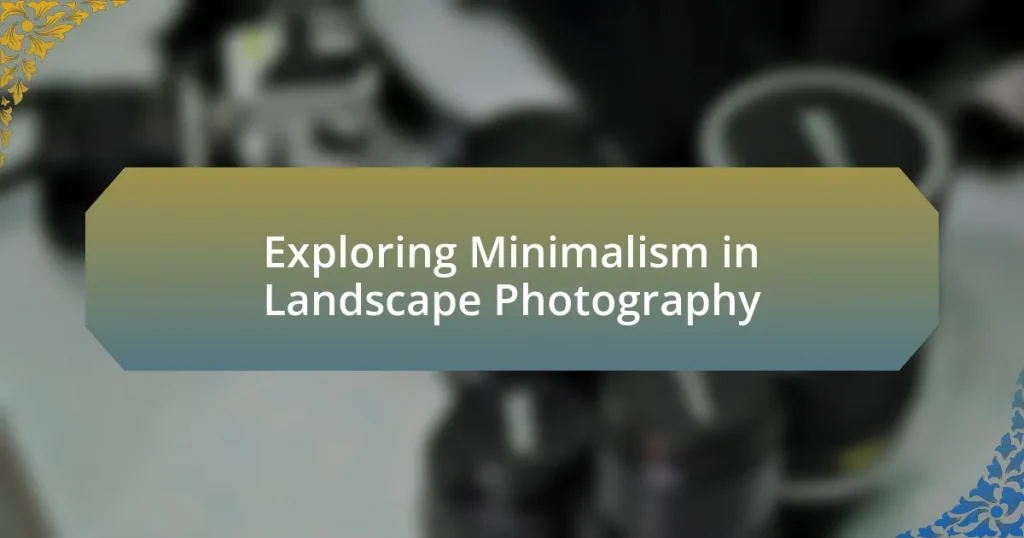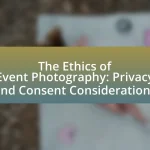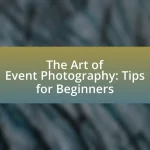Minimalism in landscape photography is a style that prioritizes simplicity by focusing on a limited number of elements within the frame, utilizing negative space, clean lines, and a restrained color palette. This approach enhances the emotional impact of images by allowing viewers to engage more deeply with the essential aspects of the scene. Key elements of minimalist composition include simplicity, negative space, and a limited color palette, which collectively create tranquil and impactful landscapes. The article also explores techniques for achieving minimalism, the role of natural light and shadows, and best practices for selecting subjects, ultimately highlighting the importance of minimalism in evoking emotional responses and challenging traditional photography norms.

What is Minimalism in Landscape Photography?
Minimalism in landscape photography is a style that emphasizes simplicity by focusing on a limited number of elements within the frame. This approach often involves using negative space, clean lines, and a restrained color palette to create a sense of tranquility and clarity. The goal is to draw attention to the essential aspects of the scene, allowing viewers to engage with the image on a deeper level. Minimalist landscape photography often showcases vast landscapes with few subjects, such as a single tree or rock formation, highlighting the beauty of the environment while eliminating distractions.
How does minimalism influence the composition of landscape photographs?
Minimalism influences the composition of landscape photographs by emphasizing simplicity and the reduction of visual clutter. This approach encourages photographers to focus on essential elements, such as lines, shapes, and colors, which enhances the overall impact of the image. For instance, a minimalist landscape photograph may feature a vast expanse of sky with a single tree, drawing attention to the interplay between the elements rather than overwhelming the viewer with details. Research indicates that minimalist compositions can evoke stronger emotional responses, as they allow viewers to engage more deeply with the subject matter by eliminating distractions.
What are the key elements of minimalist composition in landscape photography?
The key elements of minimalist composition in landscape photography include simplicity, negative space, and a limited color palette. Simplicity focuses on reducing the number of elements in the frame to emphasize the subject, allowing viewers to engage with the image without distraction. Negative space involves using empty areas around the subject to create balance and draw attention to the focal point, enhancing the overall composition. A limited color palette contributes to a cohesive and harmonious image, often utilizing monochromatic tones or subtle contrasts to evoke mood and atmosphere. These elements collectively create impactful minimalist landscapes that resonate with viewers.
How does the use of negative space enhance minimalist landscape photography?
The use of negative space enhances minimalist landscape photography by emphasizing the subject and creating a sense of balance and tranquility. Negative space, which refers to the empty areas surrounding the main subject, allows viewers to focus on the essential elements of the composition without distractions. This technique can evoke emotions and convey a deeper narrative, as seen in the works of photographers like Michael Kenna, who often utilize vast expanses of sky or water to highlight solitary trees or mountains. By reducing clutter, negative space fosters a more profound connection between the viewer and the landscape, making the image more impactful.
Why is minimalism an important approach in landscape photography?
Minimalism is an important approach in landscape photography because it emphasizes simplicity and clarity, allowing the viewer to focus on essential elements of the scene. This technique reduces distractions, highlighting the beauty of natural forms and colors, which can evoke stronger emotional responses. Studies have shown that minimalist compositions can enhance viewer engagement by creating a sense of calm and contemplation, as evidenced by the popularity of minimalist art movements. By stripping away unnecessary details, photographers can create powerful images that resonate more deeply with audiences.
What emotional responses does minimalist landscape photography evoke?
Minimalist landscape photography evokes feelings of tranquility, introspection, and a sense of wonder. The simplicity and clarity in these images often lead viewers to experience calmness and peace, as the absence of clutter allows for focused contemplation. Research indicates that minimalist art can reduce anxiety and promote mindfulness, enhancing emotional well-being. For instance, a study published in the Journal of Environmental Psychology found that exposure to minimalist designs can lead to lower stress levels and improved mood. Thus, minimalist landscape photography effectively elicits profound emotional responses by fostering a serene and reflective viewing experience.
How does minimalism challenge traditional landscape photography norms?
Minimalism challenges traditional landscape photography norms by emphasizing simplicity and the reduction of elements within a composition. Traditional landscape photography often focuses on capturing expansive scenes with rich detail and vibrant colors, whereas minimalism strips away distractions to highlight essential forms and textures. This approach encourages viewers to engage with the subject on a deeper level, fostering a sense of tranquility and contemplation. For instance, minimalist photographers like Michael Kenna utilize negative space and monochromatic palettes to evoke emotions and provoke thought, contrasting sharply with the detailed, colorful imagery typical of conventional landscape photography.

What techniques are essential for achieving minimalism in landscape photography?
Essential techniques for achieving minimalism in landscape photography include simplifying compositions, utilizing negative space, and focusing on a single subject. Simplifying compositions involves removing distracting elements to highlight the main subject, which enhances clarity and impact. Utilizing negative space allows the viewer’s eye to rest and emphasizes the subject, creating a sense of tranquility. Focusing on a single subject ensures that the photograph conveys a clear message, making it more powerful. These techniques are supported by the principles of design, which emphasize the importance of simplicity and clarity in visual art.
How can photographers effectively use light and shadow in minimalist landscapes?
Photographers can effectively use light and shadow in minimalist landscapes by carefully selecting the time of day for shooting, particularly during golden hour, when the light is soft and warm. This choice enhances textures and creates long shadows that add depth to the composition. For instance, shooting at sunrise or sunset allows for dramatic contrasts between light and shadow, emphasizing the simplicity of the landscape. Additionally, utilizing natural elements such as trees or hills can help frame the light and shadow interplay, guiding the viewer’s eye through the image. Studies in photography demonstrate that the use of chiaroscuro, the strong contrast between light and dark, can evoke emotional responses and highlight the minimalist aesthetic, making the subject stand out against a simplified background.
What role does natural light play in creating minimalist images?
Natural light is essential in creating minimalist images as it enhances simplicity and emphasizes the subject. The quality, direction, and intensity of natural light can dramatically alter the mood and perception of a scene, allowing for a clean and uncluttered composition. For instance, soft, diffused light during golden hour can create gentle shadows and highlight textures, which are crucial in minimalist photography. This use of natural light helps to isolate the subject against a serene background, reinforcing the minimalist aesthetic by reducing distractions and focusing the viewer’s attention.
How can shadows be utilized to enhance the minimalist aesthetic?
Shadows can enhance the minimalist aesthetic by creating depth and contrast in landscape photography. By strategically incorporating shadows, photographers can emphasize shapes and forms, drawing attention to the simplicity of the composition. For instance, shadows can delineate boundaries between elements, making the subject stand out against a clean background. This technique is supported by the principle that contrast enhances visual interest; studies in visual perception indicate that high contrast can lead to greater engagement from viewers. Therefore, utilizing shadows effectively can transform a minimalist scene into a more dynamic and compelling image.
What are the best practices for selecting subjects in minimalist landscape photography?
The best practices for selecting subjects in minimalist landscape photography include focusing on simplicity, identifying strong focal points, and utilizing negative space. Simplicity ensures that the subject stands out without distractions, while a strong focal point draws the viewer’s attention effectively. Negative space enhances the composition by providing balance and emphasizing the subject. These practices are supported by the principles of design, which highlight that effective minimalist compositions often rely on fewer elements to convey a stronger message.
How do photographers choose focal points that embody minimalism?
Photographers choose focal points that embody minimalism by selecting subjects that are simple, isolated, and devoid of distractions. This approach emphasizes the essence of the subject, allowing it to stand out against a clean background. For instance, a lone tree in an expansive field or a single rock on a beach can serve as effective focal points. The use of negative space is crucial, as it enhances the visual impact of the chosen subject, drawing the viewer’s attention directly to it. Studies in visual perception indicate that minimalistic compositions can evoke stronger emotional responses, as they allow for greater contemplation and interpretation by the viewer.
What types of landscapes are most conducive to minimalist photography?
Open, expansive landscapes are most conducive to minimalist photography. These landscapes, such as deserts, beaches, and vast plains, provide ample negative space that emphasizes simplicity and isolation. The absence of clutter allows the viewer to focus on singular elements, like a lone tree or a distant mountain, enhancing the minimalist aesthetic. Additionally, landscapes with soft, muted colors or monochromatic tones further support minimalist photography by reducing visual distractions and creating a serene atmosphere.

How can photographers develop their minimalist landscape photography skills?
Photographers can develop their minimalist landscape photography skills by focusing on simplicity, composition, and the use of negative space. Emphasizing a limited color palette and reducing distractions in the frame allows for a more impactful image. Practicing with different perspectives and angles helps to isolate subjects, enhancing the minimalist approach. Additionally, studying the works of renowned minimalist photographers, such as Michael Kenna, can provide inspiration and insight into effective techniques. Engaging in regular critiques of one’s own work and seeking feedback from peers can further refine skills and understanding of minimalist principles.
What are some common challenges faced in minimalist landscape photography?
Common challenges faced in minimalist landscape photography include finding suitable subjects, managing negative space, and dealing with changing light conditions. Photographers often struggle to identify focal points that convey simplicity without clutter, as the essence of minimalism relies on strong, singular elements. Additionally, effectively utilizing negative space can be difficult, as it requires a keen understanding of composition to avoid empty areas that detract from the overall impact. Finally, changing light conditions can pose a challenge, as the subtlety of minimalist scenes often demands specific lighting to enhance textures and colors, making timing crucial for capturing the desired effect.
How can photographers overcome the challenge of finding simplicity in complex scenes?
Photographers can overcome the challenge of finding simplicity in complex scenes by employing techniques such as isolating subjects, utilizing negative space, and simplifying compositions. Isolating subjects involves focusing on a single element within the scene, which reduces distractions and highlights the main subject. Utilizing negative space allows photographers to create a sense of balance and clarity by surrounding the subject with empty areas, emphasizing its importance. Simplifying compositions can be achieved by removing unnecessary elements or using framing techniques to guide the viewer’s eye. These methods are supported by principles of design that emphasize clarity and focus, which are essential in minimalist photography.
What strategies can be employed to refine a minimalist vision in photography?
To refine a minimalist vision in photography, photographers should focus on simplifying compositions by eliminating distractions and emphasizing essential elements. This can be achieved through techniques such as using negative space, which allows the subject to stand out against a clean background, and employing a limited color palette to create harmony and focus. Additionally, utilizing strong lines and shapes can guide the viewer’s eye towards the main subject, enhancing the minimalist aesthetic. Research indicates that minimalist photography often evokes a sense of calm and clarity, as seen in the works of renowned minimalist photographers like Michael Kenna, who effectively use these strategies to convey powerful imagery with minimal elements.
What tips can help photographers enhance their minimalist landscape photography?
To enhance minimalist landscape photography, photographers should focus on simplifying compositions by reducing clutter and emphasizing key elements. This can be achieved by using negative space effectively, which draws attention to the subject and creates a sense of tranquility. Additionally, selecting a limited color palette can strengthen the minimalist aesthetic, as seen in the works of renowned minimalist photographers like Michael Kenna, who often utilize monochromatic tones to evoke emotion. Finally, utilizing natural light during golden hours can enhance textures and shadows, further emphasizing the simplicity of the scene.
How can post-processing techniques support a minimalist approach?
Post-processing techniques can enhance a minimalist approach by refining images to emphasize simplicity and clarity. These techniques, such as cropping, adjusting contrast, and selectively enhancing colors, help eliminate distractions and focus the viewer’s attention on essential elements of the composition. For instance, cropping can remove extraneous details, while contrast adjustments can highlight the interplay of light and shadow, reinforcing the minimalist aesthetic. Studies in photography have shown that effective post-processing can significantly improve the visual impact of minimalist images, making them more engaging and evocative.
What are the best practices for framing and presenting minimalist landscape photographs?
The best practices for framing and presenting minimalist landscape photographs include using a simple composition, emphasizing negative space, and selecting a limited color palette. Simple compositions focus on a single subject or element, which draws the viewer’s attention and enhances the minimalist aesthetic. Emphasizing negative space allows the subject to stand out, creating a sense of tranquility and balance. A limited color palette contributes to the overall simplicity and can evoke specific emotions, making the photograph more impactful. These practices are supported by the principles of minimalist design, which prioritize clarity and focus in visual art.















